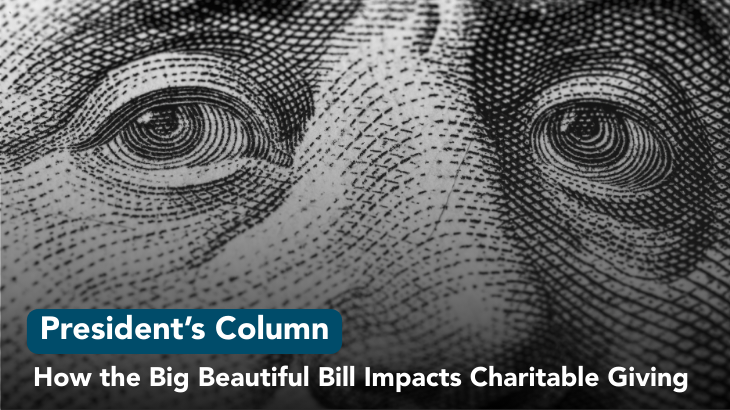
There are several new provisions impacting charitable giving in the “One Big Beautiful Bill Act” passed in July. For the many charitable people in our community, now is the time to discuss these changes with your financial advisor, your CPA, or other professional advisors, so you can do some planning and give smart.
One change in the bill is that itemized charitable deductions will be worth less next year. The bill reduces the charitable deductions of itemizers by 0.5% of their Adjusted Gross income. So, if your Adjusted Gross Income is $100,000, the first $500 of your charitable deductions cannot be deducted.
So, if you have the flexibility, pulling charitable giving into 2025 makes sense because the same gifts in 2026 will have a smaller charitable deduction. If you have a donor-advised fund, you could contribute before the year-end to your fund and then make grants in 2026.
A second provision that impacts charitable giving and is effective for the 2025 tax year is an increase in the cap on State and Local Tax deductions. The cap of $10,000 has been increased, effective this year, to $40,000. So, many more people will again be able to itemize their taxes when their deductions exceed the standard deduction, which is $31,500 for married filing jointly in 2025. In 2018, many households that had previously itemized their deductions found that the State and Local Tax cap and the increased standard deduction meant they were no longer able to itemize.
A third provision in the bill includes that starting in 2026 there is a new charitable contribution deduction for those taking the standard deduction. For households filing jointly, up to $2,000 in charitable contributions can be deducted on top of the standard deduction. In 2020 and 2021, we temporarily had this deduction, which is sometimes referred to as the Universal Charitable Deduction, but it was capped at $300 in 2020 and $600 in 2021 for married couples filing jointly. The new higher amount is permanent, but unfortunately, it is not indexed to inflation like the standard deduction. And, unfortunately, gifts to donor-advised funds are excluded in this provision.
A fourth point to note about the bill is that Qualified Charitable Distributions (QCDs) from IRAs are still allowed. There are no new tax provisions regarding this, so just a reminder that if you have an IRA and are age 70 ½ or older, making a charitable contribution directly to a charity from your IRA as a Qualified Charitable Distribution (QCD), is still a very tax wise way to give.
And when you are 73 or older and have Required Minimum Distributions (RMD), this QCD counts towards the RMD total. This year you can give up to $108,000 from an IRA. The QCD amount is not taxed like other withdrawals that are taxed as ordinary income. Contributions into donor-advised funds are still excluded from receiving a QCD. However, scholarship funds or funds designated for specific charities at a Community Foundation are eligible.
As I mentioned earlier, with all these new provisions affecting charitable giving, now is the ideal time to consult with your financial advisor, CPA, or other professional advisors to plan and give smart. If you need resources, please contact us at info@thcf.org, at Truman Heartland Community Foundation and we’ll help you make connections.





